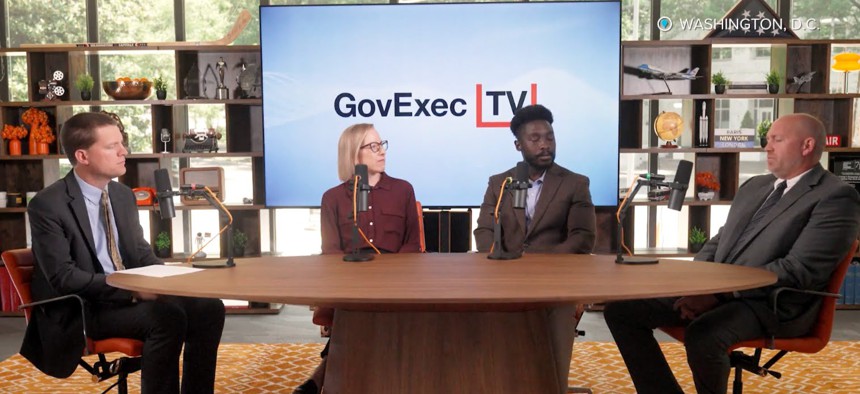How ‘continuous innovation’ means more than just product launches

Photo via GovExecTV
Speakers at Route Fifty’s recent Innovation Spotlight said governments should also modernize processes and lean on data to improve transparency and public trust.
The pace of change is accelerating in state and local governments, as agency leaders throughout the country wrestle with digitizing their services, moving away from legacy technology and embracing artificial intelligence.
But while it may be tempting for governments to focus purely on introducing new technologies in a bid to modernize, speakers during a Route Fifty Innovation Spotlight this week warned that leaders must also tackle their business processes and look to constantly refine how they do their work. Nathaniel Wentland, director of information technology for Loudoun County, Virginia, said it should create a mindset of “continuous innovation” in government.
“Doing something or putting something out and then saying, ‘OK, we're not going to touch it for five years,’ can't happen,” Wentland continued. “It's that continual agile innovation state that is essential, where it's not just IT that is leading that, but it's the business units."
That approach needs a shift in mindset, however, among government leaders and agencies. Jenny Smith, senior director of strategic investments at the Maryland Digital Service, which is housed within the Maryland Department of Information Technology, said the agency is shifting away from a project-centered approach to IT to a “product-centric approach.” It means a massive change in how the state approaches technology.
“Technology implementation is really about solving problems for users and for programs, not just about implementing systems,” Smith said. “We are focused on the users and what the users need to accomplish. We have fewer of these large modernization and migration initiatives because our products are supported in perpetuity in iterative, user-centered design. We are trying to transform the whole state to approaching technology in that way, and it's a big project.”
Baltimore, Maryland, meanwhile, is turning to data analytics to provide better visibility on traffic calming projects in the city’s neighborhoods. Whereas before, the city offered little in the way of transparency on the progress of various projects on city streets, the new dashboard-based approach helps residents get far more insight.
“We needed to create a product that provided that level of granularity on, and visibility for, residents on the things that are directly impacting their streets,” said Webster Mulbah, chief data officer at the Baltimore City Department of Transportation.
Better data analytics can result in better outcomes for various efforts. Wentland pointed to an initiative where Loudoun County uses data analytics for public safety that helped local law enforcement find a murder suspect that was trying to board a flight at the county’s Dulles International Airport.
“[The sheriff’s office] used that platform and feeds of data and information to be able to find them a lot quicker, and they found them within a few hours after the situation happened,” Wentland said. “It's something where we're using data and information to not just make it so we can analyze it, but we're using data and information to make better processes and implement those directly to allow us to do things a lot faster across the board.”
Making sure residents and employees have the chance to provide feedback on these efforts is crucial too, especially as some may not trust the increasing reliance on technology in government services. Much of that relies on surveys and other feedback forms to give officials insight, and being deliberate about listening to employee concerns.
“All the departments are my customers, and then, the residents are the department's customers,” Wentland said. “It's really just listening to people, seeing exactly where the issues are, and then trying to figure out a path forward.”
“We want the best path to also be the easiest path,” Smith said. That work will forever be ongoing, even long after public officials’ careers are over.
“There's no end state; there's no day where we're done with this work,” Smith said. “It's just forever making sure that we're doing a good job meeting users’ needs.”






